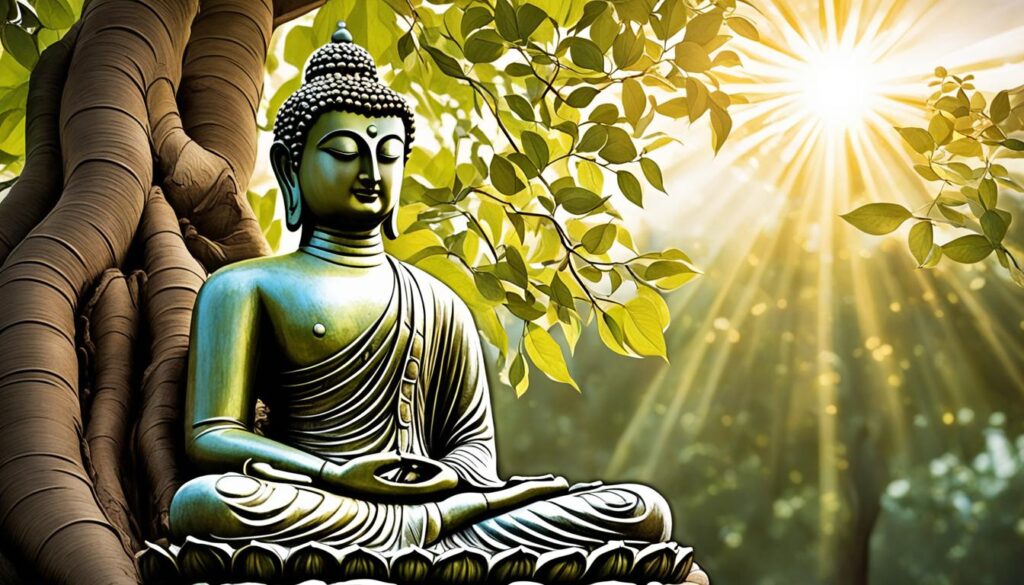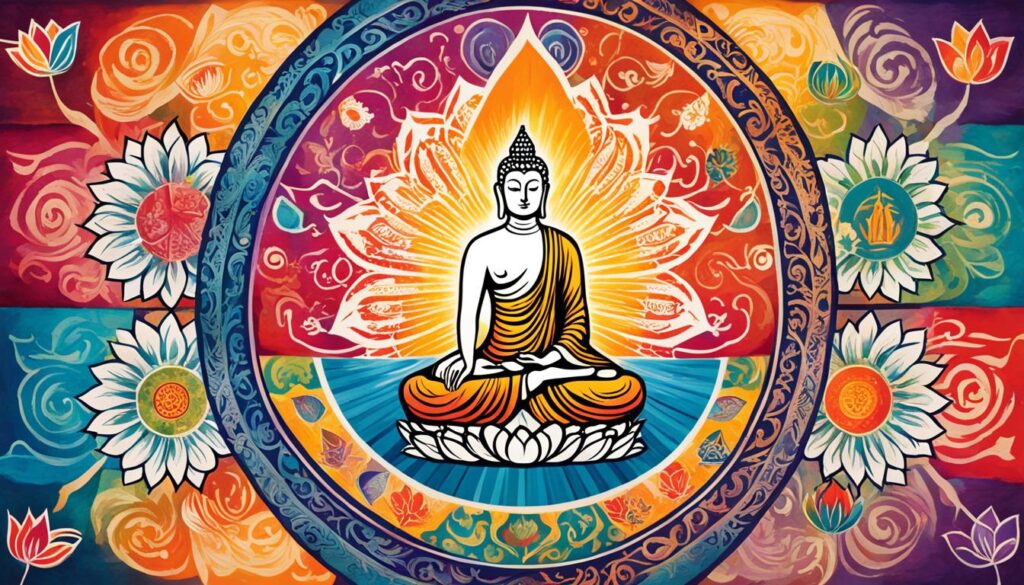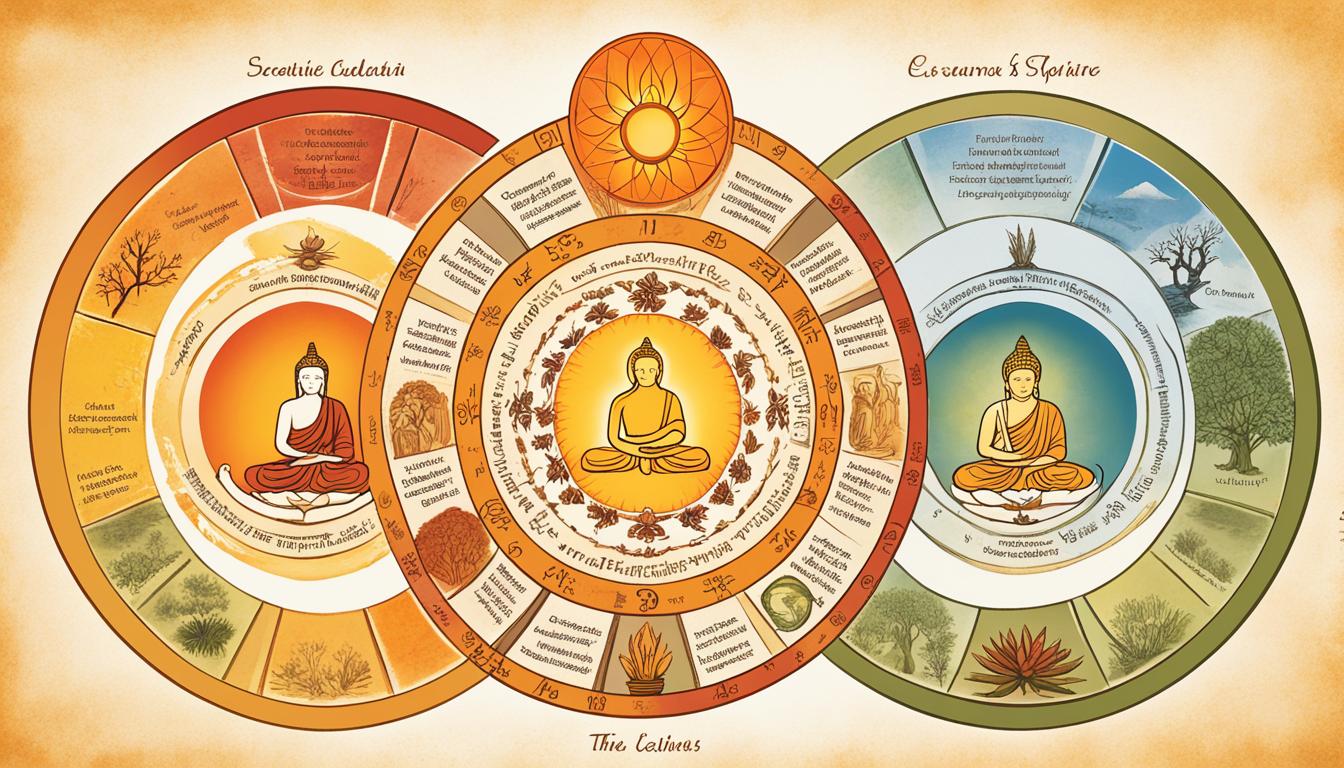“Peace comes from within. Do not seek it without.” – Buddha
Welcome to the world of Buddhism, a path that leads to inner peace and enlightenment. Buddhism is a non-theistic faith founded over 2,500 years ago by Siddhartha Gautama, also known as the Buddha. With its rich history, diverse philosophies, and profound teachings, Buddhism offers a unique perspective on life’s purpose and the nature of suffering. Whether you are curious about its principles, fascinated by its meditation practices, or intrigued by its impact on society, this article will provide you with key insights into the essence of Buddhism.
Key Takeaways:
- Buddhism is a non-theistic faith founded by Siddhartha Gautama, the Buddha, over 2,500 years ago.
- Buddhism revolves around the concept of suffering and offers teachings for achieving enlightenment and inner peace.
- Key beliefs include the Four Noble Truths, karma, and reincarnation.
- Meditation plays a vital role in Buddhism as a path to enlightenment and self-discovery.
- Buddhism has different traditions, such as Theravada, Mahayana, and Tibetan Buddhism, each with its own interpretations and practices.
Buddhism Beliefs and Practices
Buddhism offers a unique perspective on spirituality, with its beliefs and practices centered around achieving enlightenment, inner peace, and wisdom. Unlike other religions that worship a supreme deity, Buddhism focuses on personal development and self-transformation. By following a set of moral principles, engaging in meditation, and seeking wisdom, Buddhists strive to attain a state of enlightenment.
Morality: Buddhism places a strong emphasis on ethical conduct and living a virtuous life. Buddhists believe in the importance of treating others with kindness, compassion, and respect. By cultivating positive qualities and refraining from harmful actions, individuals can create a harmonious and compassionate society.
Meditation: Meditation is a fundamental practice in Buddhism, used to develop mindfulness, concentration, and insight. Through meditation, Buddhists seek to quiet the mind, gain clarity, and cultivate awareness of the present moment. This practice helps individuals achieve inner stillness and connect with their true nature.
Wisdom: Wisdom is seen as a key component of enlightenment in Buddhism. It involves the understanding of the true nature of reality and the nature of suffering. The Four Noble Truths, a central teaching in Buddhism, explain the existence of suffering, its causes, its end, and the path to liberation.
The Four Noble Truths
- Dukkha (Suffering): The First Noble Truth acknowledges the existence of suffering in life. Buddhists recognize that suffering is an inherent part of the human condition, caused by attachment and craving.
- Samudaya (Cause of Suffering): The Second Noble Truth identifies the cause of suffering as craving and attachment. It suggests that by overcoming attachment and desire, individuals can alleviate suffering.
- Nirodha (Cessation of Suffering): The Third Noble Truth offers hope by stating that the cessation of suffering is possible. Through the elimination of attachment and craving, individuals can attain liberation from suffering.
- Magga (Path to Liberation): The Fourth Noble Truth outlines the Eightfold Path, which provides guidance on how to achieve liberation from suffering. The Eightfold Path encompasses right understanding, thought, speech, action, livelihood, effort, mindfulness, and concentration.
Karma: Central to Buddhism is the belief in karma, the law of cause and effect. Buddhists understand that their actions, both good and bad, have consequences that will shape their future experiences. By cultivating positive intentions and actions, individuals can create good karma and pave the way for a more positive future.
Reincarnation: Buddhists also believe in the concept of reincarnation, the continuous cycle of rebirth. They view life as a series of interconnected existences, with each lifetime influenced by the actions and karma accumulated in previous lives. Liberation from this cycle is the ultimate goal, leading to nirvana, a state of liberation and freedom from suffering.
Whether worshiping in temples or practicing at home, Buddhists engage in rituals, ceremonies, and devotional practices designed to deepen their connection with the teachings of the Buddha. Buddhist monks, who lead a monastic lifestyle, follow a strict code of conduct and dedicate their lives to studying and teaching the dharma.
By embracing these beliefs and engaging in the practices of Buddhism, followers strive to navigate the path to enlightenment and find inner peace and wisdom.
The Founder of Buddhism
In the 5th century B.C, Siddhartha Gautama, also known as the Buddha, founded Buddhism, a non-theistic faith that has since evolved into one of the major world religions. Born into a wealthy family in present-day Nepal, Siddhartha Gautama was deeply moved by the suffering and injustices he saw in the world.
Dissatisfied with his luxurious lifestyle, he renounced his wealth and status, embarking on a spiritual journey as a wandering holy man. Years of introspection, meditation, and self-discipline culminated in a moment of enlightenment under a Bodhi tree. This spiritual awakening led him to profound insights about the nature of suffering and the path to liberation.
For the rest of his life, Siddhartha Gautama, now known as the Buddha, dedicated himself to teaching others about his transformative experiences and the principles of Buddhism. With his compassionate and wisdom-filled teachings, he sought to guide individuals on the path to enlightenment and the end of suffering.
Key Events
Key events in the life of Siddhartha Gautama, the founder of Buddhism:
- Birth: Siddhartha Gautama was born into a wealthy family in present-day Nepal.
- Renunciation: Moved by the suffering he witnessed, Siddhartha renounced his luxurious lifestyle to seek spiritual truth.
- Enlightenment: After years of rigorous spiritual practice, Siddhartha attained enlightenment under a Bodhi tree.
- Teaching: The Buddha spent the rest of his life sharing his teachings and guiding others on the path to enlightenment and the end of suffering.
Through his profound insights, the Buddha’s teachings continue to inspire and impact millions of people, making Buddhism a globally influential religion.

| Key Concepts | Description |
|---|---|
| Enlightenment | A state of spiritual awakening and liberation from suffering. |
| Path to Liberation | The practices and teachings that lead individuals to enlightenment. |
| Compassion | The virtue of showing kindness and empathy towards all beings. |
| Wisdom | The ability to understand the true nature of reality and achieve insight. |
Types of Buddhism
Buddhism has evolved into different traditions across the world. The three main types are Theravada Buddhism, Mahayana Buddhism, and Tibetan Buddhism. Each tradition has its own unique practices and interpretations of Buddha’s teachings.
Theravada Buddhism
Theravada Buddhism, also known as the “School of the Elders,” is prevalent in Southeast Asia. This tradition emphasizes the original teachings of the Buddha and focuses on individual liberation through meditation and moral conduct. The Theravada texts, known as the Pali Canon, are highly revered by followers of this tradition.
Mahayana Buddhism
Mahayana Buddhism, widely practiced in China, Japan, and other East Asian countries, centers around compassion and the pursuit of enlightenment for the benefit of all sentient beings. This tradition emphasizes the role of bodhisattvas, enlightened beings who postpone their own liberation to help others. Mahayana texts, such as the Lotus Sutra and the Heart Sutra, hold great significance in this tradition.
Tibetan Buddhism
Tibetan Buddhism, prevalent in Tibet and surrounding regions, incorporates elements of both Theravada and Mahayana traditions. It places a strong emphasis on meditation, tantra, and the guidance of spiritual leaders, such as the Dalai Lama. Tibetan Buddhism also incorporates unique practices such as the construction of intricate sand mandalas and the recitation of mantras.
Zen Buddhism
Zen Buddhism is a form of Mahayana Buddhism that originated in China and later spread to Japan. Zen emphasizes direct experience and the attainment of enlightenment through meditation and mindfulness. This tradition emphasizes simplicity and the cultivation of everyday awareness. Zen texts, such as the teachings of Zen masters and koans (paradoxical riddles), play a crucial role in Zen practice.
Each of these traditions offers its own unique approach to Buddhist practice and philosophy. While they share common roots in the teachings of the Buddha, they have evolved over time to meet the specific cultural and spiritual needs of their followers.

| Tradition | Prevalent Regions | Main Texts |
|---|---|---|
| Theravada Buddhism | Southeast Asia | Pali Canon |
| Mahayana Buddhism | China, Japan, East Asia | Lotus Sutra, Heart Sutra |
| Tibetan Buddhism | Tibet, surrounding regions | Tibetan Buddhist scriptures, including the Kangyur and Tengyur |
| Zen Buddhism | China, Japan | Teachings of Zen masters, Zen koans |
Dharma and the Four Noble Truths
Within Buddhism, the teachings of the Buddha, known as dharma, hold great significance. Dharma emphasizes the cultivation of important virtues such as wisdom, kindness, and compassion. These teachings provide guidance for individuals on their spiritual journey, enabling them to attain enlightenment and inner peace.
One of the essential components of the Buddhist scriptures is the Tipitaka, also known as the Three Baskets. It comprises the collection of Buddha’s sayings and rules for Buddhist monks. These scriptures serve as a profound source of wisdom and guidance for followers of Buddhism.
The Four Noble Truths form the cornerstone of Buddhist philosophy and offer crucial insights into human existence. They explain the nature of suffering, its cause, its end, and the path to liberation. The Four Noble Truths provide a profound understanding of the human experience and the means to transcend suffering.
- The First Noble Truth: Suffering exists in life.
- The Second Noble Truth: The cause of suffering is attachment and craving.
- The Third Noble Truth: The cessation of suffering is attainable.
- The Fourth Noble Truth: The Eightfold Path leads to the end of suffering.
The Eightfold Path serves as a practical guide for ethical conduct, mental discipline, and wisdom. It consists of eight interconnected principles: right understanding, thought, speech, action, livelihood, effort, mindfulness, and concentration. By following the Eightfold Path, individuals can lead virtuous lives, cultivate mental clarity, and achieve enlightenment.

Understanding the Four Noble Truths
Let’s explore the Four Noble Truths in more depth:
| Noble Truth | Description |
|---|---|
| The First Noble Truth | Recognizing the existence of suffering as an inherent part of human existence, encompassing physical, emotional, and existential pain. |
| The Second Noble Truth | Understanding that suffering arises from attachment, desire, and craving, leading to dissatisfaction and discontentment. |
| The Third Noble Truth | Realizing that the ultimate goal is to put an end to suffering by eliminating the causes of attachment and craving. |
| The Fourth Noble Truth | Embracing the Eightfold Path as the means to attain liberation from suffering and achieve enlightenment. |
The Four Noble Truths offer a profound understanding of human suffering and present a path towards liberation and inner peace. By following the teachings of dharma and embracing the Eightfold Path, individuals can transform their lives and cultivate a greater sense of wisdom and compassion.
Meditation in Buddhism
Meditation is an essential practice in Buddhism, used to achieve inner stillness and enlightenment. Buddhists look within themselves for truth and understanding. Meditation can take various forms, such as sitting quietly, practicing martial arts, contemplating riddles or poems, or focusing on the breath. It is a way to cultivate mindfulness and be fully present in one’s life. Nirvana, freedom from suffering, is sought through meditation and the awakening of truth.
To embark on the path of Buddhist meditation, it is important to engage in mindfulness. By practicing mindfulness, you bring your attention to the present moment, immersing yourself completely in the experience without judgment or attachment. This state of awareness allows you to observe your thoughts and emotions without becoming entangled in them, fostering a deeper understanding of the nature of reality.

Meditation Practices in Buddhism
In Buddhism, there are various meditation practices that can be explored to develop mindfulness and cultivate inner peace. These practices include:
- Anapanasati meditation: This type of meditation involves focusing on the breath, observing the inhalation and exhalation with complete attention. By anchoring the mind to the breath, you can develop concentration and calmness.
- Walking meditation: Walking meditation involves moving slowly and mindfully, paying attention to each step and the sensations in the body. This practice encourages a deep connection with the present moment.
- Loving-kindness meditation: Loving-kindness meditation cultivates feelings of compassion, love, and kindness towards oneself and others. It involves directing positive thoughts and well-wishes to oneself, loved ones, and even individuals who may be perceived as challenging.
- Body scan meditation: In this practice, you systematically scan your body from head to toe, bringing awareness to each part. This meditation helps develop body awareness and promotes relaxation.
These meditation practices in Buddhism are not limited to a specific technique or ritual but are adaptable to individual preferences and needs. The ultimate goal is to develop concentration, mindfulness, and insight, leading one closer to the experience of nirvana.
| Meditation Practice | Key Benefits |
|---|---|
| Anapanasati meditation | Enhances focus and concentration |
| Walking meditation | Brings mindfulness into movement and daily activities |
| Loving-kindness meditation | Develops compassion, empathy, and positive emotions |
| Body scan meditation | Promotes relaxation and body awareness |
The Role of the Dalai Lama
The Dalai Lama serves as the leading figure in Tibetan Buddhism, embodying the spiritual wisdom and teachings of this ancient tradition. Believed to be the reincarnation of a past enlightened Lama, the Dalai Lama is revered as a spiritual leader and guide for millions of followers around the world.
For centuries, the Dalai Lama has played a significant role in both spiritual and political matters in Tibet. He has acted as the spokesperson for Tibetan Buddhism, promoting its principles of compassion, mindfulness, and inner peace. The Dalai Lama’s influence extends beyond the boundaries of religion, as he has become a symbol of hope and unity for people of diverse backgrounds.
Unfortunately, the Dalai Lama and the Tibetan people have faced immense challenges due to the Chinese takeover in 1959. Despite this adversity, the Dalai Lama continues to inspire and lead by example, spreading the message of Tibetan Buddhism and advocating for peace, human rights, and freedom for his people.
The Current Dalai Lama: Lhamo Thondup
The current Dalai Lama, Lhamo Thondup, was born in 1935. As the 14th Dalai Lama, he assumed the role at a young age and has dedicated his life to promoting the principles of Tibetan Buddhism. His teachings emphasize the importance of compassion, love, and understanding in fostering harmony among individuals and societies.
Despite living in exile since 1959, the Dalai Lama has become an influential figure on the global stage. His teachings, wisdom, and advocacy for peace have earned him recognition and respect from people of various faiths and cultures.
| Role | Influence | Global Impact |
|---|---|---|
| Spiritual Leader | The Dalai Lama serves as the spiritual guide and mentor for millions of Tibetan Buddhists, providing guidance on the path to enlightenment and inner peace. | The Dalai Lama’s teachings on compassion, mindfulness, and ethical conduct have resonated with people across the globe, serving as an inspiration for millions in their spiritual journeys. |
| Political Figure | Through his political leadership, the Dalai Lama has advocated for the autonomy and freedom of Tibet, highlighting the challenges faced by the Tibetan people. | The Dalai Lama’s advocacy for human rights and freedom has gained international recognition, raising awareness about the plight of the Tibetan people and fostering support for their cause. |
| Peace Ambassador | The Dalai Lama promotes peace, understanding, and dialogue as a means to resolve conflicts and bridge cultural divides. | His efforts to promote peace and nonviolence have earned him numerous awards and accolades, solidifying his global reputation as a prominent peace advocate. |
The Dalai Lama’s presence and teachings continue to inspire individuals in their quest for spiritual enlightenment and personal growth. His unwavering commitment to compassion, peace, and justice serves as a guiding light for all those who seek a more harmonious world.
Conclusion
Buddhism, with its profound teachings and beliefs, offers invaluable guidance on your spiritual journey. By emphasizing mindfulness, compassion, and addressing the causes of suffering, Buddhism remains highly relevant in addressing the challenges of the modern world. Its teachings empower individuals to cultivate inner peace and wisdom, fostering personal growth and a deeper understanding of oneself and others.
At the heart of Buddhism lies the essence of compassion—for oneself and all living beings. This core principle encourages you to develop empathy, kindness, and love, creating a more harmonious and compassionate society. By addressing the root causes of suffering, Buddhism not only transforms individual lives but also has a profound impact on our interconnected global community.
Millions of people around the world have embraced Buddhism, finding solace, guidance, and enlightenment within its teachings. Its enduring impact spans the realms of philosophy, psychology, spirituality, and social justice. Through practices such as meditation, mindfulness, and ethical living, Buddhism provides practical tools for navigating life’s challenges and cultivating inner peace.
FAQ
What is Buddhism?
Buddhism is a non-theistic faith founded by Siddhartha Gautama, also known as “the Buddha,” over 2,500 years ago in India. It is considered one of the major world religions and revolves around the concept of suffering, its causes, and teachings for achieving enlightenment and inner peace.
What are the beliefs and practices of Buddhism?
Buddhism teaches followers to focus on achieving enlightenment, which emphasizes morality, meditation, and wisdom. The Four Noble Truths, karma, and reincarnation are important concepts in Buddhism. Worship can be done in temples or at home, and Buddhist monks follow a strict code of conduct.
Who is the founder of Buddhism?
The founder of Buddhism is Siddhartha Gautama, also known as the Buddha. He renounced his luxurious lifestyle and attained enlightenment, spending the rest of his life teaching others about the path to enlightenment and the end of suffering.
What are the types of Buddhism?
There are three main types of Buddhism: Theravada Buddhism, Mahayana Buddhism, and Tibetan Buddhism. Zen Buddhism is a form of Mahayana Buddhism that emphasizes simplicity and meditation. Each tradition has its own interpretations of Buddha’s teachings and reveres certain texts.
What is Dharma and the Four Noble Truths?
Dharma refers to the teachings of the Buddha, which emphasize virtues such as wisdom, kindness, and compassion. The Four Noble Truths explain the nature of suffering, its cause, its end, and the path to liberation. The Eightfold Path provides guidance for ethical conduct, mental discipline, and wisdom.
What is the role of meditation in Buddhism?
Meditation is an essential practice in Buddhism, used to achieve inner stillness and enlightenment. It can take various forms, such as sitting quietly, practicing martial arts, or focusing on the breath. Meditation cultivates mindfulness and being fully present in one’s life, leading to the ultimate goal of nirvana, freedom from suffering.
What is the role of the Dalai Lama?
The Dalai Lama is the leading monk in Tibetan Buddhism and is believed to be the reincarnation of a past lama. The Dalai Lama has played a significant role as both a spiritual and political leader in Tibet until the Chinese takeover in 1959.
What impact does Buddhism have?
Buddhism offers profound teachings and beliefs that guide individuals on their spiritual journey. Its emphasis on mindfulness, compassion, and addressing the causes of suffering makes it relevant to addressing modern challenges. Buddhism provides insights for personal and societal harmony and continues to impact millions of lives worldwide.

